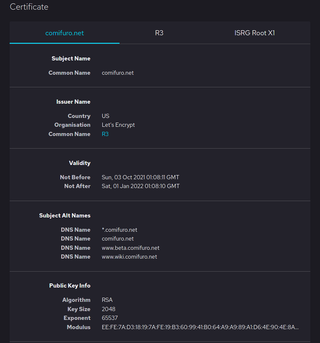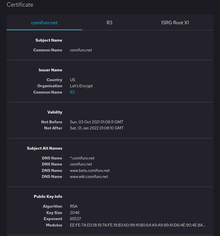
Hypertext Transfer Protocol Secure (HTTPS) is an extension of the Hypertext Transfer Protocol (HTTP). It uses encryption for secure communication over a computer network, and is widely used on the Internet. In HTTPS, the communication protocol is encrypted using Transport Layer Security (TLS) or, formerly, Secure Sockets Layer (SSL). The protocol is therefore also referred to as HTTP over TLS, or HTTP over SSL.
X.500 is a series of computer networking standards covering electronic directory services. The X.500 series was developed by the Telecommunication Standardization Sector of the International Telecommunication Union (ITU-T). ITU-T was formerly known as the Consultative Committee for International Telephony and Telegraphy (CCITT). X.500 was first approved in 1988. The directory services were developed to support requirements of X.400 electronic mail exchange and name lookup. The International Organization for Standardization (ISO) and International Electrotechnical Commission (IEC) were partners in developing the standards, incorporating them into the Open Systems Interconnection suite of protocols. ISO/IEC 9594 is the corresponding ISO/IEC identification.

A public key infrastructure (PKI) is a set of roles, policies, hardware, software and procedures needed to create, manage, distribute, use, store and revoke digital certificates and manage public-key encryption. The purpose of a PKI is to facilitate the secure electronic transfer of information for a range of network activities such as e-commerce, internet banking and confidential email. It is required for activities where simple passwords are an inadequate authentication method and more rigorous proof is required to confirm the identity of the parties involved in the communication and to validate the information being transferred.
In cryptography, a public key certificate, also known as a digital certificate or identity certificate, is an electronic document used to prove the validity of a public key. The certificate includes the public key and information about it, information about the identity of its owner, and the digital signature of an entity that has verified the certificate's contents. If the device examining the certificate trusts the issuer and finds the signature to be a valid signature of that issuer, then it can use the included public key to communicate securely with the certificate's subject. In email encryption, code signing, and e-signature systems, a certificate's subject is typically a person or organization. However, in Transport Layer Security (TLS) a certificate's subject is typically a computer or other device, though TLS certificates may identify organizations or individuals in addition to their core role in identifying devices. TLS, sometimes called by its older name Secure Sockets Layer (SSL), is notable for being a part of HTTPS, a protocol for securely browsing the web.
In cryptography, X.509 is an International Telecommunication Union (ITU) standard defining the format of public key certificates. X.509 certificates are used in many Internet protocols, including TLS/SSL, which is the basis for HTTPS, the secure protocol for browsing the web. They are also used in offline applications, like electronic signatures.
In cryptography, a certificate authority or certification authority (CA) is an entity that stores, signs, and issues digital certificates. A digital certificate certifies the ownership of a public key by the named subject of the certificate. This allows others to rely upon signatures or on assertions made about the private key that corresponds to the certified public key. A CA acts as a trusted third party—trusted both by the subject (owner) of the certificate and by the party relying upon the certificate. The format of these certificates is specified by the X.509 or EMV standard.
CAcert.org is a community-driven certificate authority that issues free X.509 public key certificates. CAcert.org relies heavily on automation and therefore issues only Domain-validated certificates.
S/MIME is a standard for public-key encryption and signing of MIME data. S/MIME is on an IETF standards track and defined in a number of documents, most importantly RFC 8551. It was originally developed by RSA Data Security, and the original specification used the IETF MIME specification with the de facto industry standard PKCS #7 secure message format. Change control to S/MIME has since been vested in the IETF, and the specification is now layered on Cryptographic Message Syntax (CMS), an IETF specification that is identical in most respects with PKCS #7. S/MIME functionality is built into the majority of modern email software and interoperates between them. Since it is built on CMS, MIME can also hold an advanced digital signature.
In cryptography and computer security, self-signed certificates are public key certificates that are not issued by a certificate authority (CA). These self-signed certificates are easy to make and do not cost money. However, they do not provide any trust value.
The Online Certificate Status Protocol (OCSP) is an Internet protocol used for obtaining the revocation status of an X.509 digital certificate. It is described in RFC 6960 and is on the Internet standards track. It was created as an alternative to certificate revocation lists (CRL), specifically addressing certain problems associated with using CRLs in a public key infrastructure (PKI). Messages communicated via OCSP are encoded in ASN.1 and are usually communicated over HTTP. The "request/response" nature of these messages leads to OCSP servers being termed OCSP responders.
Xcitium, formerly known as Comodo Security Solutions, Inc., is a cybersecurity company headquartered in Bloomfield, New Jersey.
GeoTrust is a digital certificate provider. The GeoTrust brand was bought by Symantec from Verisign in 2010, but agreed to sell the certificate business in August 2017 to private equity and growth capital firm Thoma Bravo LLC. GeoTrust was the first certificate authority to use the domain-validated certificate method which accounts for 70 percent of all SSL certificates on the Internet. By 2006, GeoTrust was the 2nd largest certificate authority in the world with 26.7 percent market share according to independent survey company Netcraft.

An Extended Validation Certificate (EV) is a certificate conforming to X.509 that proves the legal entity of the owner and is signed by a certificate authority key that can issue EV certificates. EV certificates can be used in the same manner as any other X.509 certificates, including securing web communications with HTTPS and signing software and documents. Unlike domain-validated certificates and organization-validation certificates, EV certificates can be issued only by a subset of certificate authorities (CAs) and require verification of the requesting entity's legal identity before certificate issuance.
The Certification Authority Browser Forum, also known as the CA/Browser Forum, is a voluntary consortium of certification authorities, vendors of Internet browser and secure email software, operating systems, and other PKI-enabled applications that promulgates industry guidelines governing the issuance and management of X.509 v.3 digital certificates that chain to a trust anchor embedded in such applications. Its guidelines cover certificates used for the SSL/TLS protocol and code signing, as well as system and network security of certificate authorities.

A Public key certificate which uses an asterisk * in its domain name fragment is called a Wildcard certificate. Through the use of *, a single certificate may be used for multiple sub-domains. It is commonly used for transport layer security in computer networking.
DNS-based Authentication of Named Entities (DANE) is an Internet security protocol to allow X.509 digital certificates, commonly used for Transport Layer Security (TLS), to be bound to domain names using Domain Name System Security Extensions (DNSSEC).
Certificate Transparency (CT) is an Internet security standard for monitoring and auditing the issuance of digital certificates.
Let's Encrypt is a non-profit certificate authority run by Internet Security Research Group (ISRG) that provides X.509 certificates for Transport Layer Security (TLS) encryption at no charge. It is the world's largest certificate authority, used by more than 300 million websites, with the goal of all websites being secure and using HTTPS. The Internet Security Research Group (ISRG), the provider of the service, is a public benefit organization. Major sponsors include the Electronic Frontier Foundation (EFF), the Mozilla Foundation, OVH, Cisco Systems, Facebook, Google Chrome, Internet Society, AWS, NGINX, and Bill and Melinda Gates Foundation. Other partners include the certificate authority IdenTrust, the University of Michigan (U-M), and the Linux Foundation.
DNS Certification Authority Authorization (CAA) is an Internet security policy mechanism that allows domain name holders to indicate to certificate authorities whether they are authorized to issue digital certificates for a particular domain name. It does this by means of a "CAA" Domain Name System (DNS) resource record.

The Automatic Certificate Management Environment (ACME) protocol is a communications protocol for automating interactions between certificate authorities and their users' servers, allowing the automated deployment of public key infrastructure at very low cost. It was designed by the Internet Security Research Group (ISRG) for their Let's Encrypt service.




